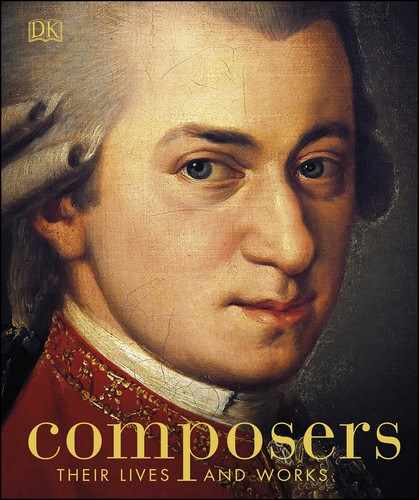Domenico Scarlatti
1685–1757, ITALIAN
Italian Scarlatti wrote his most famous works in Spain. His fiery keyboard sonatas, incorporating elements of Spanish popular music, defied the rules of composition and extended the range of keyboard technique.

DOMENICO SCARLATTI
This portrait made by Domingo Antonio Velasco in 1739 commemorates Scarlatti’s initiation into the Spanish Order of Santiago the previous year.
IN PROFILE
Alessandro Scarlatti
Domenico Scarlatti’s father, Alessandro, was the leading Italian opera composer of his period. Born in Palermo, Sicily, in 1660, he spent most of his working life in Naples, where he was appointed maestro di cappella at the Viceregal Chapel; he also worked in Rome, Florence, and Venice. His output was phenomenal, including more than a hundred operas as well as a host of oratorios and cantatas. His most highly regarded work is Il Mitridate Eupatore, first staged in 1707. Heavily in debt, he died in Naples in 1725.

SCORE OF ALESSANDRO SCARLATTI’S LA CADUTA DEL DECEMVIRI (1682–1683)
Giuseppe Domenico Scarlatti was born in Naples in 1685—an auspicious year that also saw the birth of J.S. Bach and Handel. He was a child of opera composer Alessandro Scarlatti (see box), who had his son appointed organist at the Neapolitan royal chapel at the age of 15. Although Domenico showed exceptional ability as a keyboard player, his father insisted he write vocal music, and his first opera was performed in Naples in 1703.
In 1709, Scarlatti obtained a post as in-house composer for Queen Maria Casimira of Poland, who was living in exile in Rome. Over the following five years, he wrote seven operas for the queen’s theater and also established a reputation as a harpsichord virtuoso.
Royal duties
In 1715, Scarlatti was appointed maestro di cappella at St. Peter’s, the position Palestrina had once held, but he was increasingly frustrated by his subjection to his father’s authority and by being forced to focus on vocal music. In 1719, he accepted an invitation to join the royal court of Portuguese King Joao V in Lisbon. One of his duties was to teach music to the king’s nine-year-old daughter, Princess María Bárbara de Bragança. When she married the future king of Spain in 1729, Scarlatti accompanied her to Seville and then to Madrid, where he lived at the court for the rest of his life.

BARBARA OF PORTUGAL
Scarlatti wrote pieces for his talented keyboard student, Princess María Bárbara de Bragança.
Keyboard innovation
On a visit to Rome, Scarlatti married 16-year-old Maria Caterina Gentili in 1728. The couple had six children before she died in 1739. The composer fathered four more offspring with a second wife, Anastasia Maxarti Ximenes, the last born when he was 64.
During his years in Spain, Scarlatti wrote the 555 single-movement keyboard sonatas for which he is renowned. Mostly intended for the harpsichord, they reveled in unexpected modulation and harmonic dissonance, exploiting a wide range of innovative techniques including the crossing of hands. Many of their original effects were inspired by Spanish folk music, with echoes of guitar-strumming, castanets, stamping dance rhythms, and flamenco song. The publication of 30 sonatas under the title Exercises in 1638 established Scarlatti’s Europe-wide reputation, but little more of his music was published in his lifetime.
Since Scarlatti’s death in Madrid in 1757, the rest of the keyboard works have been gradually rediscovered. Although little of his vocal music is highly rated today, Scarlatti’s sonatas have an idiosyncratic “modern” feel that guarantees their popular place in the repertoire.

HARPSICHORD FROM 1725
Scarlatti was a master of the harpsichord. In a keyboard competition with Handel in Rome, judges estimated Handel to be superior at the organ but Scarlatti the better harpsichordist. One contemporary described his playing “as if ten hundred devils had been at the instrument.”
